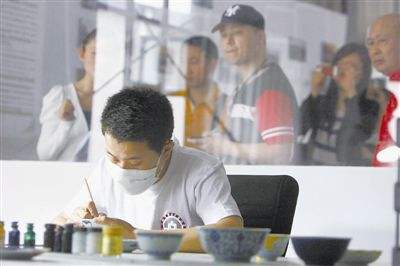First of all, it is the call of the times to strengthen the heritage of cultural relics protection and repair skills, and the social situation is very important. China is a great cultural heritage. In the history of more than 5000 years, the Chinese nation has created a rich and precious cultural heritage. According to the December 23, 2017 twelve session of the thirty-first meeting of the NPC Standing Committee of the second plenary meeting of the State Council on cultural heritage "work report", China's current total registration of immovable cultural relics 766722, state-owned movable cultural relics 108 million pieces (sets), intangible cultural heritage resources 870 thousand. These cultural heritage, carrying the splendid civilization of the Chinese nation, is the cultural card of our country and the treasure of human civilization. As of July 2017, 52 projects in China were listed in the world heritage list by UNESCO and ranked second in the world. In November 14, 2017, at the twenty-first meeting of the conference of the States parties to the Convention on the protection of world cultural and natural heritage held in Paris, China was elected member of the World Heritage Committee. In China's rich cultural heritage resources, cultural relics are undoubtedly an important part. China's cultural relic resources can be rated as world-class in terms of quantity and quality. So many cultural relics preservation is not easy, but with the passage of time, by the natural climate and the changes of social environment factors, these cultural relics damage is unavoidable, and repair work is imperative to strengthen the protection of cultural relics. But at present, engaged in the protection and restoration of cultural relics nationwide professionals only thousands of people, compared with the number of protection and restoration of cultural relics, there is a great gap between the restoration of cultural relics, lack of talents is a major realistic problem. It is imminent to strengthen the training of the protection and restoration of cultural relics. Cultural relics protection and restoration of China's traditional old generation of cultural relic protection and restoration experts as an example, they treated in awe of cultural relics, repair work to do to reduce their damage to cultural relics, even in a small detail is cautious to micro, such as bronze to rust, they use mud, plum plum the red mud paste and paste on the bronze to slowly get rid of rust, need long hours, but these materials of soft not to hurt the bronze. This kind of work experience is the essence of these experts to repair ideas and methods. If we do not focus on strengthening the inheritance and learning of these traditional repair techniques, it is very likely that these traditional skills will be gradually forgotten when new materials and methods are emerging. The simple adoption of new materials and new methods has some side effects on the restoration and protection of cultural relics. Combining the traditional repair technology with modern restoration technology, the two complement each other is the perfect repair rule.

Secondly, there are some restrictions on the traditional heritage protection and repair skills, and need to be innovating. The protection of cultural relics and the inheritance of the traditional restoration techniques Chinese mainly through teacher-student relationship, by the master and apprentice teaching oral teaching that inspires true understanding within, after many years of practice to understand and master the skills. This way of inheritance usually takes a long time. Due to the energy of the teacher, the number of the disciples is limited. Therefore, the inheritance of this technology is very narrow, and it can not meet the social needs of a large number of professionals in China. Therefore, along with the traditional heritage protection and repair techniques, we need to innovate and explore a more broad way of learning. To reform the traditional inheritance path of cultural relic protection and restoration techniques, the first problem to be solved is the cultural relics protection and restoration techniques and skills through various means to record the old generation of experts on the protection of traditional cultural relics and restoration technology and consolidation depth mining, into the literature or film data for reference then, expand the transmission range of traditional repair techniques. The solution of this problem requires the introduction of the method of oral history.
Again, the development of oral history like a raging fire, the study on the theory and method of mature, application areas continue to expand, in addition to the development of a variety of cross history, anthropology, folklore, sociology, archives, journalism and other disciplines, especially in the studies of cultural heritage intangible cultural heritage research field, the application of oral history can be said it has a revolutionary significance. The oral history method is applied to the protection of intangible cultural heritage. By transferring people's oral knowledge, it can preserve data of literature or video, and expand the scope of dissemination. It plays a booster role in the protection of intangible cultural heritage. Cultural relic protection and restoration technology is also an important intangible cultural heritage. The research method of oral history applied to its inheritance path is feasible.
Finally, the introduction of oral history is a new exploration of the heritage path of cultural relics protection and restoration. Theoretically, the oral history method is applied to the cultural relics protection and restoration of heritage skills, through the development of cultural relics protection and restoration of oral interviews with experts, sound recording or video recording, photography, text records and other forms, and cultural relics protection and restoration of various skills directly related to the scientific record, and then carry out research, on the one hand can be on the verge of extinction from desperate rescue skill recovery, on the other hand records can also be compiled and published, and even become the compilation of teaching materials, physical display and the spread of the broader, provide a reference for the later more study of cultural relic protection and restoration techniques. Of course, from theory to practice but also need to do a lot of preparatory work, there will be some new problems may be the specific operation process, such as how to mobilize the cultural relic protection and restoration experts actively involved, how to effectively protect the development of schools of traditional art heritage restoration and so on, which requires the protection of intellectual property rights from the legal level, communicate communication from the ideological level and cultural relic protection and restoration experts, to clarify the significance of oral history work. In any case, the application of the method of oral history, provides a new approach for extending the protection of cultural relics and art heritage restoration path, expanding the cultural relic protection and restoration techniques spread through oral history, inspire more cultural relics protection and restoration of art lovers, learners and researchers to join the ranks, a respect for the older generation of cultural relics protection with the restoration experts in the community, the protection of traditional cultural heritage and carry forward the art of repairing the social atmosphere, the construction of China's cultural relics and cultural power is helpful. (this is the stage result of the project funded by the optimization plan of the University of Beijing Union University)


